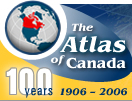|
ABORIGINAL PEOPLES IN CANADA circa 1823 depicts
an early nineteenth century European view of the Aboriginal population
in Canada. The year 1823 was selected for this map because unusually
complete population and locational data are available for a large part
of Canada from a census ordered by
the Governor and Committee of the Hudson's Bay Company in 1822.
In the early 1820s the aboriginal population of what is now Canada
stood at about 150 000, a significant drop from the 200 000 estimated
for the 1740s and 250 000 estimated for the early 1630s. Up to
the late 18th century this decline was largely due to epidemic diseases
and to a lesser extent warfare. As the 19th century progressed,
disease continued to take a dreadful toll across Canada, but starvation
increasingly manifested itself in the eastern parts of the country
where the spread of European settlement, overhunting and overtrapping
were changing the Aboriginal subsistence base.
Hudson's Bay Company 1822 Census of the Aboriginal
Population
In 1821, the Northwest Company and the Hudson's Bay Company, the last
remaining major fur companies in British North America, merged after many
years of fierce competition. This merger made it necessary to take stock
of posts, personnel, transportation systems, and fur and food resources
in the vast territory now under monopoly control. This reappraisal was
needed in order to rationalize the fur trade into a profitable system
based on a sustained yield.
 [D] [D]
Click for larger version, 12 KB
The North West Company house on Vaudreuil Street, Montreal. The company was first formed in the 1770s by a group of fur merchants.
One aspect of this reappraisal was a census of the Aboriginal population
ordered on February 27, 1822, by the Governor and Committee of the Hudson's
Bay Company. In accordance with these instructions, George Simpson, Governor
of the Company's Northern Department, issued a directive to the traders
in the various districts:
"…to furnish particular reports of the general
total of Indians within their jurisdiction; particularizing the Tribes,
Chiefs, Heads of Families and followers, with the District of Country
in which they hunt…"
By the end of 1823, most officers of the Company had complied; some in
astonishing detail. Since the above was made a standing order, additional
information was gathered with the expansion of trade into new areas
or as traders gained greater familiarity with the various aboriginal
groups with whom they had contact. Although the individual enumerations
and estimates by the traders were never compiled into a comprehensive
report, the data were used by the Company in its planning process.
|
